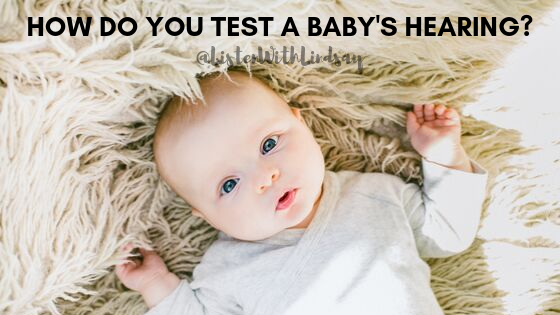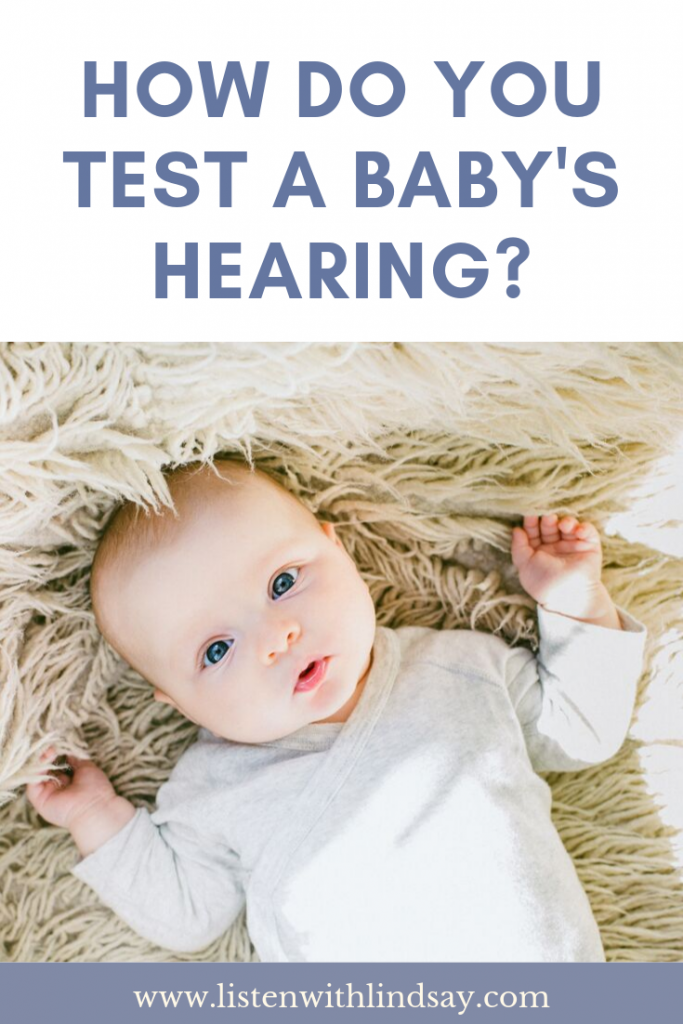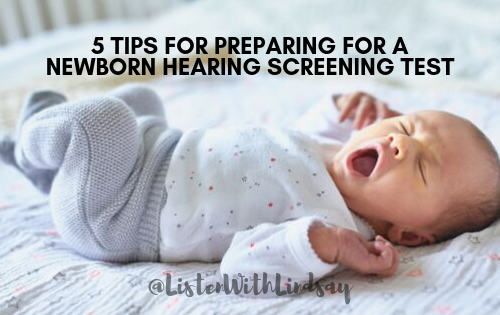
How Do You Test a Baby’s Hearing?
After I tell someone I’m a pediatric audiologist which means I test baby’s hearing the next question I get is “How exactly do you test baby’s hearing?” Since it’s National Newborn Screening week I thought it was a great time to share!
Newborn Hearing Screening
Newborn Hearing Screening at the Hospital
All babies born in the USA and in many (but not all) other countries receive a newborn hearing screening before they leave the hospital.
Newborn Hearing Screening for Home Birth and Birthing Center Births
If you have a home birth or give birth in a birthing center you will need to seek this test out by asking your pediatrician for a referral.
Pass or “Refer”
There are 2 results of a Newborn Hearing Screening – Pass or “Refer” aka fail or did not pass. There is no “30% pass.” There is no “almost pass”. You either pass or you don’t pass.
The purpose of a screening is to divide the population into two groups – those that need further testing and those that do not need further testing at this time.
What does it mean if a baby does not pass or fails the newborn hearing screening?
It RARELY (but not never) means your baby is totally deaf.
It ALWAYS means you should follow-up and get more testing ASAP to get more answers to find out why the baby didn’t pass.
What does it mean if a baby passes the newborn hearing screening?
If a baby passes the newborn hearing screening and there are no other risk factors or concerns about the baby’s hearing, then they do not need any immediate additional testing.
Passing the newborn hearing screening does not guarantee normal hearing. It is set up to be a very good system for determining who needs more testing and who doesn’t. It’s very good at detecting which babies potentially have hearing loss without referring too many babies that have normal hearing.
If you ever have a concern about your baby’s hearing you should ALWAYS request your pediatrician refers them for another test even if they passed.
If Your Doctor Won’t Refer You for a Hearing Test
If you request a referral and get push back from your doctor you can say something like “Yes I really hope I get to come back here and tell you you were right and that their hearing is fine. Let’s get the test just to be sure.”
Luckily this hasn’t been as much of an issue in later years, but there’s some doctors that aren’t up to date. Listen to your intuition if you are concerned.
Do not take no for an answer. If all else fails ask if there is another doctor or nurse practitioner you can speak to.
Are Hearing Tests for Babies Invasive?
A hearing test is a non-invasive procedure for a baby or child. There is 0 risk or possible complications while doing a (non-sedated) hearing test on a baby or child. There are huge risks in terms of speech and language delays, social-emotional difficulties, and academic challenges that come with undiagnosed or late diagnosed hearing losses.
Newborn Hearing Screening Process
The process can vary depending on where you live and the clinic(s) you go to for follow-up.
Initial Inpatient Screening
Generally there are 1 (or 2 if the baby does not pass) screenings completed in the hospital.
Outpatient Re-screen
If the baby does not pass they are typically referred to an outpatient re-screen. The outpatient re-screen is typically completed 1-2 weeks after the inpatient screening. This way if the baby has fluid from the birth (vernix) or middle ear fluid it has time to possibly drain on its own.
At the outpatient re-screening, the faster and more simple pass/refer type of test is used again to determine if the baby needs further testing.
If the baby does not pass again they will be referred for a diagnostic ABR test. Some clinics will begin this test the day of the re-screening immediately after the baby fails. Other clinics will have the family come back a few weeks later to complete the test.
If your baby is born without an ear (has microtia/atresia) they should not be referred for an outpatient re-screen they should be referred immediately to a diagnostic ABR test.
Diagnostic Auditory Brainstem Response (ABR) Testing
Babies that do not pass the outpatient re-screen need diagnostic ABR testing. This can be completed the same day the baby fails the outpatient re-screening (depending on the clinic), or the baby may be scheduled for 2 weeks+ later depending on appointment availability.
Diagnostic Auditory Brainstem Response (ABR) Testing
A baby’s hearing can be tested using ABR (sometimes called BAER for Brainstem Auditory Evoked Response) testing. Electrodes are placed on the baby’s head and around the ear. A headphone or insert earphone is placed in the baby’s ear. The earphone plays a sound and the electrodes record the brain’s response to the sound.
Typically the audiologist will play a louder sound first to see a bigger response, then turn the volume down to see where they no longer see the response. This gives a very accurate estimate of what sounds a baby is hearing and what sounds they are not hearing.
ABR Screening vs. Diagnostic ABR
ABR testing is also used for the newborn hearing screening. The difference between an ABR screening and a diagnostic ABR is that the screening version plays 1 sound (a “click” which is a range of frequencies that are important for understanding speech) at 1 volume (usually 30-35dB which is the mild hearing loss range). The screening just determines if the response is present (Pass) or not (“Refer”/fail).
The diagnostic ABR is used to find the threshold aka the softest sound a baby can hear. Ideally the audiologist would get an ABR threshold for 500, 1000, 2000, and 4000Hz for the right and left ears during a diagnostic ABR.
They would also get diagnostic ABR thresholds for all frequencies that have hearing loss in either ear via ear-specific bone conduction. This is in an ideal perfect world.
Inconclusive or Incomplete results
In the real world babies wake up, time runs out, and not all audiologists know what they’re supposed to be looking for and sometimes will only get a click ABR threshold which is not enough to determine the type and configuration of hearing loss.
It’s fairly common that a baby needs more than 1 diagnostic ABR test to get the complete results. The more you prepare the baby and yourself for the test the more likely it is that the audiologist will be able to get conclusive information.
Why does an ABR take so long?
The goal of a diagnostic ABR evaluation is to determine what sounds a baby is hearing, what sounds they are not hearing, and if the problem is temporary or permanent.
This takes a lot of testing which is why the appointment is typically 1.5-4 hours. The appointment has to also factor in that not all babies fall asleep immediately and not all babies stay asleep the entire time. It also factors in the extensive time it can take to counsel a family if a hearing loss is found.
Why does a baby have to be asleep for an ABR?
ABR tests use electrodes on the head and near the ear to record the brain’s response to sounds. If a baby is awake their eyes will be moving which moves the muscles that are near the electrodes. The muscle movement can create noise or “artifact” and make it difficult and sometimes impossible to determine if a response is present or if it’s a false “response” because of the movement.
When babies are sleeping soundly after they have eaten (so they are not nursing or sucking on a bottle and without a pacifier) this creates the best environment for recording accurate ABR results. Results can sometimes be obtained when a baby is sucking on a pacifier or eating quietly, but it often takes longer because more responses must be measured and repeated.
What if my baby won’t sleep for the hearing test?
The instructions for the ABR screening and diagnostic test can cause anxiety in a lot of parents. All you need to do is prepare as best you can and hope for the best. The more anxious you are the more difficult it will be for your baby to fall asleep.
The younger your baby is the easier it is to do the test. Newborns sleep most of the day so they can’t stay awake forever.
How to Relax
It is normal and ok to be a bit nervous about the test and the results. Most parents are surprised when their babies do not pass. It’s important to take care of yourself during this time.
Remember that no matter what the results are, you and your baby will be OK. If you have internet access and can read and understand this blog post, you have more resources than most and will likely be better than OK.
It’s still OK to feel sad and scared. Talk to someone you love about it. Make plans well in advance about who will come with you to the appointment so you feel prepared and supported.
It’s common for family members and loved ones (and sometimes even medical professionals) to dismiss your concerns and say “they’re fine! it’s probably just fluid!” Just know they are trying their best to be helpful and supportive and they don’t really know how to react or deal with this either.
You may feel powerless. Just know that planning, preparing and showing up to the test is power. Getting results and the information you learn gives you power. Following up and getting the help you and your baby needs is power. These are the only things you have control over. The fear of the unknown is much scarier than knowing the results and the plan. You’ve got this!




